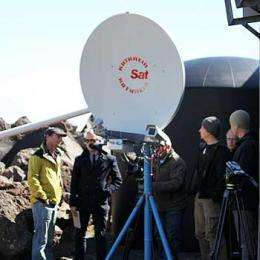Volcanologists have eye on the sky

(�鶹��ԺOrg.com) -- Volcanologists from Massey University and the University of Hamburg in Germany will soon be able to record every explosive burst out of Mt Ruapehu in rain or shine, day or night, with a new high-speed Doppler Radar system.
It is the first of its kind in New Zealand and makes Ruapehu one of only a handful of volcanoes around the world watched around the clock by a radar “eye”. Last week GNS Science upgraded the aviation alert to yellow following a sustained rise in the temperature of the crater lake.
The last month has seen the team, together with staff from Ruapehu Alpine Lifts and the Department of Conservation, installing the radar at Whakapapa.
The instrument has a 1.2m diameter radar dish (pictured right) that focuses its narrow beam precisely over the crater lake to immediately detect any explosive jet or ash-laden eruption column that rises more than 200m.
Professor Matthias Hort, a geophysicist from Hamburg, says the Doppler effect is like listening to an ambulance passing on the street. “As it comes towards you the siren is high-pitched, but it sounds much lower pitch when driving away,” Professor Hort says. “This difference in pitch or frequency can be used to calculate the ambulance’s speed. The volcanic radar uses radio waves, inaudible for the human ear, to track the velocity of particles moving within the radar beam.”
Director of the University’s Volcanic Risk Solutions team Professor Shane Cronin says the radar will become an important addition to the existing range of warning instruments installed at Mt Ruapehu.
“This is an experimental tool at present and there needs to be a lot of further research to calibrate what signals of different eruptions will look like at Mt Ruapehu,” Professor Cronin says. “While we wait on the next eruption, we will work with the same type of instrument at the constantly erupting Stromboli volcano in Italy. Only once this instrument is calibrated, can it be used for the regular monitoring and warning activities carried out by Department of Conservation, GeoNet and GNS Science.”
Unlike seismometers, which measure vibrations of the ground, and barometers, which record shock-waves generated by volcanic eruptions in the air, the radar directly detects the volcanic particles thrown out of the crater lake, often at several hundred metres per second.
University volcanologist Dr. Gert Lube says the radar penetrates through darkness, clouds and mist and can give reliable and rapid eruption warnings even when we cannot see the summit by eye.
“Besides detecting eruption signals in real-time, we will have a new view inside of an eruption that has never been recorded elsewhere.” Dr. Lube says. “The radar beam spans the entire width of the crater lake, but will also be able to measure the speed of volcanic surges and snow-slurry lahars that travel over the Whakapapa skifield, like those in 1995 and 2007.
Dr. Lube says they will also be able to view any eruption columns that rise into the atmosphere to capture their violence and dynamics. “This can help us calculate the energy and mass flux of an eruption column to provide estimates of how large an eruption might become, and how much ash-fall could be expected down wind.”
The project has been developed in partnership with the Department of Conservation, GNS Sciences and Ruapehu Alpine Lifts. It is funded through an $80,000 grant from Massey University as well as ongoing travel support from the Royal Society of New Zealand, and the German Ministry for Research, Science and Technology.
Provided by Massey University












.jpg)





